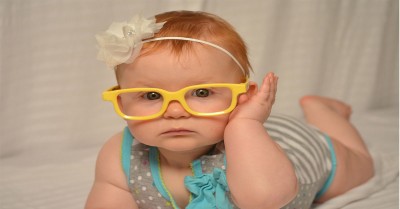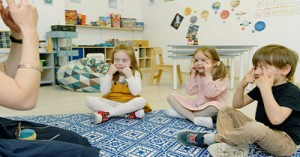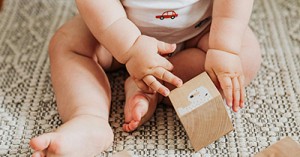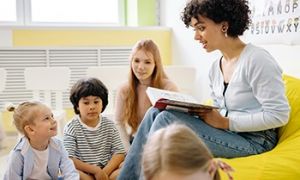As Educators working with children, it's important to understand each theoretical approach and use parts of different theorists in context. Each theorist’s ideas are independent of the other, but when put together, they give us a good overall understanding of how children develop as they age. The following is an overview of popular child theorists, a brief description of their theories and how to implement their theories into practice within the early childhood environment.
Erick Erickson
He developed a psychosocial theory to understand how we each develop our individual identities: why some of us are independent and others needy; feel able or useless; optimistic or pessimistic. He believed people develop through 8 stages. At each stage, there is one important problem or issue to solve in order to develop a healthy sense of self.
Erikson's Theories in Practice
• As Educators, we form attachments with children.
• We respond warmly and consistently to babies’ needs.
• We talk gently to babies if we can’t pick them up or deal with their needs right away.
• Tune in to children’s interests and skill levels and offer just enough support to help them do things for themselves.
• Provide a variety of play experiences so children can explore and choose what to do.
• Never pressure a child into toileting before they are ready.
• Provide play spaces with lots of movable parts so children can organize and develop their own play
• Invite children to contribute to the program, what they want to do.
• Respect their play and give them time.
Jean Piaget
He discovered that all children’s intellectual development progressed through four stages, beginning in infancy and are completed by adolescence. Thinking becomes more and more complex as the child ages. Each stage of thinking causes the child to see the world in a different way. He indicated that a child must ‘master’ one stage before they can move on to the next stage. If they cannot master a stage, they will never reach their full potential. Piaget believed that intellectual development controls every other aspect of development. He believed that there is a pattern to the way children learn to think and this pattern goes in stages. Children learn in different ways at different ages. Children are little researchers. They learn by using their senses to explore how things work. Piaget says that telling children lots of facts about a thing, without letting them find out about the thing for themselves, is not very helpful. They need to be able to see, touch, taste, smell, move, and hear the things they are learning about. This is called ‘concrete learning’.
Piaget’s Theories in Practice
• Educator's nurturance (comfort, teaching, and play) should be suitable for the individual child's stage of thinking.
• We need to develop an understanding of what children can and cannot do based on their age and intellectual ability.
• We should offer tasks that enable a child to achieve and to challenge their skills. If they are given tasks that are too difficult for them, they will not be able to succeed, which may affect them negatively, psychologically and emotionally.
• See children as active learners, listen to their ideas
• Help children find their own answers
• Know that babies will use materials in a different way to toddlers; toddlers differently to preschoolers
• Look for children’s interests and plan to build on them
• Let children repeat an activity, sometimes many times, when we can see that it is still interesting to them
Lev Vygotsky
Vygotsky emphasised the importance of relationships and interactions between children and more knowledgeable peers and adults. He believed that children’s cognitive understandings were enriched and deepened when they were ‘scaffolded’ by parent, teachers or peers. Social interactions involve communicating, so Vygotsky also emphasised the role of language in the development of the child's thinking processes. Vygotsky also sees the child's ability to think logically as developing in stages. He has outlined four different stages of conceptual development.
Vygotsky’s Theories in Practice
• Vygotsky’s zone of proximal development means that children learn with the guidance and assistance of those in their environment.
• Educators will know that children will need assistance and will know when to step in and guide the child to support them in the learning process.
• Children need interactions on a one-to-one basis and these conversations will assist their learning.
John Dewey
He believed that children need to interact with other people, work both alone and cooperatively with their peers and adults. Education should also reflect the child’s interests and backgrounds and that their social and cultural worlds are important. Dewey saw learning as lifelong and that educators need to not only teach skills and knowledge but also help children to live and exist in our society.
Dewey’s Theories in Practice
• Educators need to observe children to determine the experiences children are interested in and are ready for.
• Educators need to be able to guide children’s learning, engage their minds, and work collaboratively with children and not just instruct.
• Curriculum needs to be purposeful and assist children to make sense of the world.
• Educators should decide on the curriculum based on children’s abilities and knowledge – to decide what is safe and appropriate for them to learn.
• Educators should encourage problem-solving and critical thinking for children.
• Observe and document in depth in order to plan to where children are.
• Understand the meaning of experiences for children.
Howard Gardner
Gardner proposed a theory of multiple intelligences that suggests there is more than one intelligence – He considers children and adults to be individuals who all have skills and areas that we enjoy and excel at and that these fit into our major intelligence. When you are good at a task, you enjoy completing that task or similar
tasks and so are more likely to continue to develop and build on your skills in that area and become even better. Gardner saw the arts and creativity as playing major roles in children’s learning. Children are able to explore many cognitive concepts through their play and creative explorations.
Gardner’s Theories in Practice
• Learning occurs in social settings and contexts.
• Instead of educators being the sole facilitator of learning, children should be encouraged as ‘peer mentors’ assisting each other to learn and develop skills.
• As educators, we need to provide learning opportunities for children that reflect their ‘intelligence’ and learning style.
• Educators should be able to assist children to transfer skills they have to learn and develop into other areas
• Provide children with a wide range of learning opportunities.
• Educators should present material in ways that take into account the different bits of intelligence, rather than focusing on the traditional verbal and mathematical ways of teaching.
B F Skinner
Skinner's theory is based on "operant conditioning" – behaviour is followed by a consequence and the nature of the consequence modifies the tendency to repeat the behaviour – a method of learning through rewards and punishment.
He introduced the concepts of positive reinforcement (i.e. if the desired behaviour occurs something good happens) and negative reinforcement (i.e. when a bad behaviour is stopped by the desired behaviour). Extinction is when nothing happens when the behaviour happens and eventually the behaviour will stop. Intermittent reinforcement (mix positive reinforcement with extinction) was the best way to ensure behaviour continued.
Skinner’s Theories in Practice
• Children learn through trial and error.
• Educators should provide positive feedback and negative feedback to try to influence a child’s behaviour.
• There is support for the notion of simple rewards, such as positive support for children's emotional needs, but "punishment" is not supported.
Uri Bronfenbrenner
Bronfenbrenner sees the world in which the child grows as having a major influence on development. He describes this as a two-way influence. The personality and behaviour of the child will influence the way people in the environment will interact with that child. He also believes that the interactions between environmental factors could affect the child’s development. For instance, it is not just the influence of the parents on the child or the childcare centre on the child but the way the parents and Educators get on. This process of interacting influences is known as reciprocal interaction. Bronfenbrenner recently modified his theory and acknowledged that the child’s biological hereditary makeup combines with environmental forces to mould development.
Bronfenbrenner’s Theories in Practice
• Educators need to foster positive relationships with children and families.
• Our interaction and support for families will affect their children’s development.
• Ensure that we present programs within our service that reflect the needs and expectations of the society, culture and community in which our children live.
Arnold Gesell
He believed that children develop in an orderly sequence set by heredity. Development won’t occur until the child is ready for it to occur. Gesell was recognized for his pioneering advances in the methodology of carefully observing and measuring behaviour, and describing child development.
Gesell’s Theories in Practice
• If a child is not ready for a specific task or to move up a level, keep them back until they are ready.
• Teaching children before they are ready is not ok
• Each child is unique and the environment should teach them the uniqueness
Maria Montessori
Montessori stressed that children learn best by using their senses and pursuing their interests, rather than forcing them to learn what is expected. Children have innate skills and talents. There are sensitive periods that indicate when the child is ready to learn. To maximize children’s learning, Montessori believed that teachers should provide the necessary resources for children to learn independently, and intrude on the children’s learning experience as little as possible. If children are guided with love they will learn on their own.
Montessori’s Theories in Practice
• Educators will ensure that there are blocks of uninterrupted time for playing.
• Children explore and use Montessori materials and equipment.
• Children are given hands-on learning opportunities.
• The program and environment will be ordered and the children will have the opportunity to be involved in the routine life of the service including meal preparation and cleaning.
• Encourage independence - let the child choose
• Be non-directive; the child will show you what they need
• Do not yell at the child for unintentional mistakes
• Educators should construct the child's learning environment
• Absorb learning through different experiences
Mildred Parten
Parten’s theory focuses on social play and its development, the ability to join groups of other children and the desire to do so begins at an early age and progresses through a developmental sequence. Parten focused on the different types of social play. In her research, she discovered that children of different ages actually played together differently. They were capable of different levels or categories of social play. Parten’s stages:
Unoccupied play
Solitary play
Onlooker play
Parallel play
Associative play
Co-operative play
Parten’s Theories in Practice
• The categories of social play are still useful tools to help focus us on how social play changes and develops at different stages of children’s lives.
• Educators should understand that Parten’s stages are not always followed in a linear fashion by all children.
• A child may not progress directly from one stage to another.
• Educators need to understand that children may engage in different stages of social play depending on factors such as familiarity with either the situation or their playmates or the child’s temperament.
Kenneth H Rubin
Rubin’s and his associate’s studies have done much to clarify the developmental levels of children’s play in light of our knowledge about children. They also have identified ‘how’ children play and how it correlates with Parten’s Stages of Social Play.
Rubin’s Theories in Practice
• Do small-group and large-group activities
• Understand that children play together differently
• Social play changes depending on the child’s stage.
Theories enable educators to draw upon a range of perspectives to understand a child's learning and development. It provides an opportunity for educators to discuss different theories and beliefs and to investigate why children act in the way that they do and challenge traditional ways of seeing children
Further Reading
Erik Erikson - Psychosocial Development - Article on Erik Erikson and his psychosocial theory on how to understand how we each develop our individual identities through eight stages of psychosocial development from infancy to adulthood.
Howard Gardner - Multiple Intelligence - Article on Howards Gardner's multiple intelligence theory.
Child Theorists Posters - The following posters of 11 popular child theorists provide a brief description of their theory and how their theories are implemented into practice within the early childhood environment. These posters are great to use as a display within the service or as a reminder for Educators on the different types of child developmental theories which they can refer to and use within their documentation.
Kenneth Rubin - Theories Of Play - Article on Kenneth Rubin's developmental levels of children’s play in light of our knowledge about children.
John Dewey's Theory - The following provides information about John Dewey, the Definition Of The Curriculum, the Main Features Of Dewy's Theory of Education, Progressive Education and Dewey's Theories In Practice.
References:
Butler Creative, Linking Theorists to the EYLF Outcomes, 19 March 2017
Child Development Theorists and Theories, Lesson 17, Family Consumer Sciences
CHCFC301A, SieLearning, TAFE NSW
Urie Bronfenbrenner, Wikipedia
John Dewey, Wikipedia
Theory Of Multiple Intelligences, Wikipedia







 As an Educator in Australia, your pay rate falls under the Children’s Services Award 2010. This award states the minimum amount that an employer can
As an Educator in Australia, your pay rate falls under the Children’s Services Award 2010. This award states the minimum amount that an employer can When working as a qualified Early Childhood Teacher (with a university degree) within a service, your rate of pay will come from the Educational Services
When working as a qualified Early Childhood Teacher (with a university degree) within a service, your rate of pay will come from the Educational Services When working as a Diploma Qualified Educator your pay rate is from the Children's Services Award 2010. This Award states your minimum rate of pay
When working as a Diploma Qualified Educator your pay rate is from the Children's Services Award 2010. This Award states your minimum rate of pay When working as a Cert 3 Qualified Educator, your pay rate is from the Children's Services Award 2010. This Award states your minimum rate of
When working as a Cert 3 Qualified Educator, your pay rate is from the Children's Services Award 2010. This Award states your minimum rate of Educational Leaders play a crucial role in their early childhood service by ensuring that the educational program aligns with best practices and supports the holistic
Educational Leaders play a crucial role in their early childhood service by ensuring that the educational program aligns with best practices and supports the holistic In early childhood education and care, ratios are more than a technicality—they are a frontline safeguard. Every child deserves responsive supervision, emotional connection, and developmental
In early childhood education and care, ratios are more than a technicality—they are a frontline safeguard. Every child deserves responsive supervision, emotional connection, and developmental With the new national child safety reforms kicking in on 1 September 2025, early childhood services like yours have a real opportunity to lead the
With the new national child safety reforms kicking in on 1 September 2025, early childhood services like yours have a real opportunity to lead the Here’s a comprehensive Mobile Phone and Smart Watch Policy tailored for early childhood education and care (ECEC) services in Australia, aligned with the latest 2025
Here’s a comprehensive Mobile Phone and Smart Watch Policy tailored for early childhood education and care (ECEC) services in Australia, aligned with the latest 2025 The Sea of Fish Challenge is a national initiative that invites children, educators, families, and communities to create and display fish artworks as a symbol
The Sea of Fish Challenge is a national initiative that invites children, educators, families, and communities to create and display fish artworks as a symbol Across the early childhood education and care sector, educators are sounding the alarm: current staffing ratios are insufficient to deliver safe, meaningful, and developmentally appropriate
Across the early childhood education and care sector, educators are sounding the alarm: current staffing ratios are insufficient to deliver safe, meaningful, and developmentally appropriate


